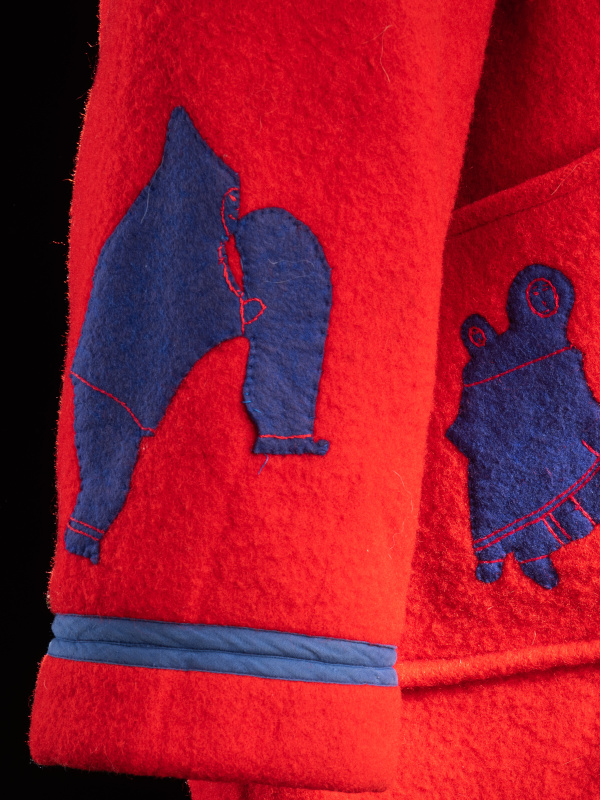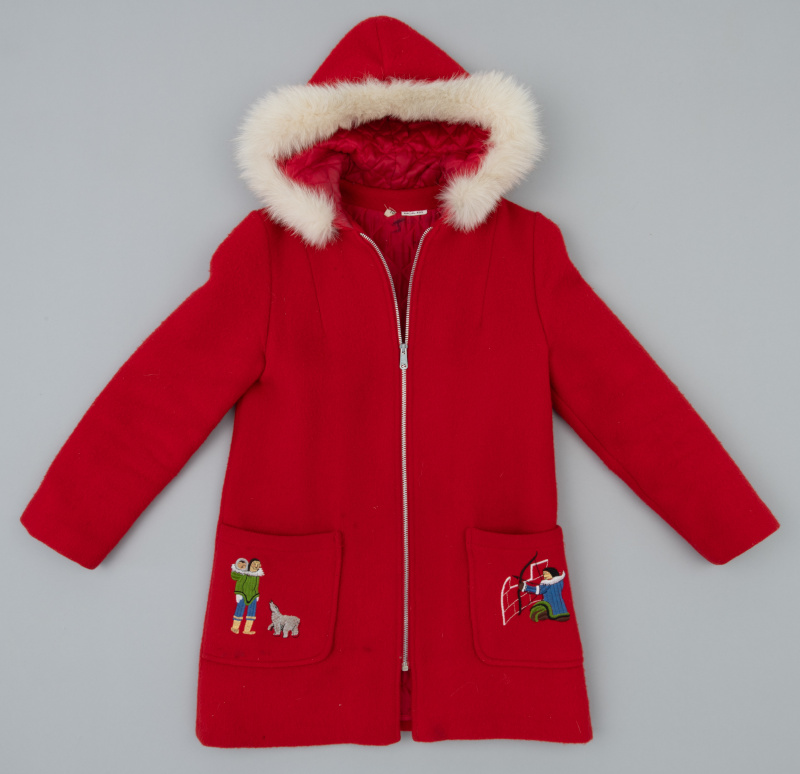Warm outerwear is essential in a Canadian winter. But many of us take for granted the things we rely on to stay warm and dry. The toques, mitts, scarves, boots, long johns, and jackets almost fade from view as just the “stuff” of daily life.
But thinking historically about our winter gear — in this case, parkas — can bring the everyday to our attention in new and sometimes surprising ways.
Jim Hunter’s 1972 Olympic parka
This winter parka was part of the Team Canada uniform at the 1972 Sapporo Winter Olympics. It belonged to Jim Hunter, an alpine skier who wore it to the opening ceremonies.
Hunter was a member of the Canadian men’s ski team between 1970 and 1977. During his career, he regularly ranked in the Top 10. In 1972, he won bronze at the FIS (International Ski Federation) World Championships, the first Canadian to achieve this feat. His daring style on the slopes earned him the nickname “Jungle Jim” and he was one of the original “Crazy Canucks.”
You can watch the 1976 National Film Board documentary about Hunter’s quest to become the best skier in the world here.

Jim Hunter’s 1972 Olympic parka.
Canadian Museum of History, IMG2023-0236-0027-Dm
Less is known about the people who made the iconic Olympic parka he wore. The Inuk master artist Germaine Arnaktauyok helped design them. Twelve seamstresses from Iqaluit whose names have yet to be confirmed gathered at the Frobisher Bay Arts and Crafts Centre and made 96 parkas for Team Canada. These garments are the product of a longstanding cultural tradition, made by experienced practitioners of traditional craft.
Each parka was made entirely by hand from red wool and decorated with blue Inuit motifs. The hoods were trimmed with white wolf fur, while the buttons were made from caribou antler.
An everyday Indigenous technology: The parka
Historian Christina Williamson describes parkas as an old and varied Indigenous technology. Distinct designs existed for men, women and children in different periods and in different Arctic regions. Traditionally, parkas were lightweight and made of caribou and seal hides. But they could also have fur, beads, peaked hoods, pouches, and . Intricate patterns, measurement systems, and particular ways of stitching were handed down verbally, often from older to younger women.
Parkas developed from a deep knowledge of the Arctic region. They reveal the entwined nature of people, animals, and the land. These coats were vital to survival and to activities like hunting and fishing. They prevented cold weather from seeping in and could naturally break down without generating waste. Parkas also circulated as gifts and commodities. Their beautiful designs reflect the lives and perspectives of their makers.

The 1972 parkas feature traditional design elements.
Canadian Museum of History, IMG2023-0236-0029-Dm
Over time, and with increasing contact with southern settler cultures, Inuit seamstresses started to adapt traditional techniques and master new materials. The introduction of elements such as zippers, synthetic threads, new fabrics, and European tailoring demonstrates the constantly evolving nature of this ancient technology. Through continual adaptation, parkas have remained an enduring symbol of Inuit pride, identity, skill and ingenuity.
Outerwear and early winter sports clubs in Canada
Indigenous outwear was fundamental to the development of a vibrant winter sports scene in Canada during the mid- to late 19th century. Winter sports helped newcomers adjust to an inhospitable climate of snow and ice, and also fostered an emerging sense of Canadian identity and nationhood.

This postcard from 1881 shows the importance of winter gear and outdoor activities in the era of Canada’s early winter sports clubs.
Canadian Museum of History, 2013-H0006
Montréal was a hub of winter sports activity. The Montréal Snow Shoe Club was established in 1840 and was the first of its kind in North America. Soon after, organizations for skating, tobogganing, skiing, curling, and other winter pastimes appeared. From the 1880s onwards, places like Halifax, Québec City, Ottawa, Toronto, Kingston, and Winnipeg boasted calendars bursting with winter sport activities.
These early winter sports clubs catered to affluent men and reflected the race, class and gender order of the time. Historian Beverly Lemire notes that while Indigenous technologies — such as winter coats, toboggans, and snowshoes — were essential to these new sport organizations, Indigenous Peoples themselves were largely excluded.
The historic exclusion of Indigenous groups from mainstream winter sport organizations had an enduring legacy. The 1972 Olympic Games represent an important milestone in this regard. Not only did Team Canada wear Inuit-made parkas, but it included Indigenous athletes. Twin sisters and cross-country skiers Sharon Anne and Shirley Firth, members of the Gwich’in First Nation, became the first Indigenous women to represent Canada in the Winter Olympics.
You can watch Sharon Anne Firth describe the pride and excitement she felt as an Olympian in this video from Shaping Canada, an oral history project of the Canadian Museum of History.

Sharon Firth in 2019, being interviewed for the Shaping Canada oral history project.
Canadian Museum of History
Dr. Roger Jackson’s 1984 Olympic parka
At the 1984 Sarajevo Olympics, the Canadian Olympic team once again sported red parkas for the opening ceremonies. The Museum has in our collection Dr. Roger Jackson’s parka from these Games.
Dr. Jackson was a three-time summer Olympian and would go on to have a distinguished academic and administrative career. He served as the dean of kinesiology at the University of Calgary, the president of the Canadian Olympic Association, the director of Sport Canada, and the chief executive officer of Own the Podium.

Dr. Roger Jackson’s 1984 Olympic parka.
Canadian Museum of History, IMG2023-0377-0013-Dm
At first glance, the 1984 Olympic parka resembles the 1972 Olympic parka. But a closer look reveals important differences. The 1984 version was produced by Sears Canada. It features machine stitching, synthetic fur fringes, and metal zippers. The later parka is more industrial in its design and production, and no longer fully biodegradable.
It is unclear who designed and made the 1984 parkas. It was common for Inuit seamstresses to be hired for piecework by large southern companies like Sears or Eaton’s, but it’s not known if any worked on these parkas. This is one of the questions that I hope to answer in my continuing work with these objects. Regardless of who constructed them, these parkas are notably different in materials and sourcing than the Team Canada outfits from 12 years earlier.
Searching for history in everyday “stuff”
Most of us don’t have an Olympic parka hanging in our front closet.
But chances are, there’s a warm winter jacket. That garment has a history. Its design, materials, uses, users, and makers are all part of the story. By searching for multiple stories in everyday objects, we expand the idea of what counts as history, and of who or what has contributed to it.

Sarah Barnes
Sarah Barnes joined the Museum in 2023 as Curator, Sport and Leisure. She is a former Assistant Professor of Experiential Studies in Community and Sport at Cape Breton University, and holds an MA and a PhD from the School of Kinesiology and Health Studies at Queen’s University.
Read full bio of Sarah Barnes